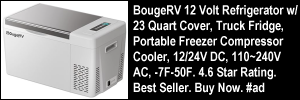Are you thinking of attending one of the many truck driver training schools throughout the country to start your career as a professional truck driver?
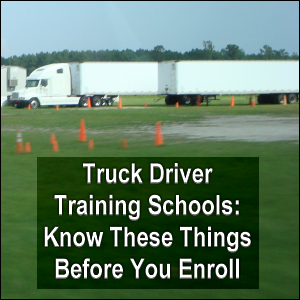 If so, there are some things you need to know before you enroll.
If so, there are some things you need to know before you enroll.
While the school you select will be only the first of your truck driving schools, you need to be adequately prepared for life on the road.
With the information below, you’ll be well on the way to a long and profitable career as a successful professional driver.
Truck Driver Training Schools: Skip the Hype
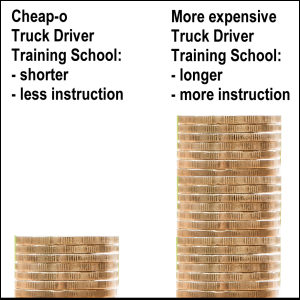 Vicki once visited a site on the Internet that attempted to answer the question, “Why Become a Truck Driver?”
Vicki once visited a site on the Internet that attempted to answer the question, “Why Become a Truck Driver?”
On that site, she saw advertisements from different truck driver training programs.
Excerpts from some of them were:
- “On-Site CDL Training in 2 weeks!”
- “CDL in 16 days” and
- “CDL Training in JUST 3 wks!”
Ok, time out. Let’s skip the hype, shall we?
Learning to drive a commercial vehicle with a gross combination weight rating of 26,001 pounds or more and trailer exceeding 10,000 pounds gross vehicle weight rating simply cannot be done adequately in three weeks or less!
Any school promising to do so will skip teaching you critical skills that you need to know.
The truck driver training school program we attended back in 1992 was 8 weeks long and we were grateful for every day of it.
It took that long for us to adjust to the size of the vehicle and the scope of the jobs that we would be doing.
Our Recommendation
We recommend schools that utilize the standards of the Professional Truck Driver Institute.
As we describe on our become a truck driver page, “Every prospective truck driver must first acquire the knowledge (via classroom training) and skills (via driving range training) to get a CDL (commercial driver’s license)” in order to get a job.
A really good reason for you to consider going to an independent training school instead of getting company paid CDL training is to keep from being exploited by an unscrupulous trucking company.
Truck Driver Training Schools: Pre-Qualification and Admission Requirements
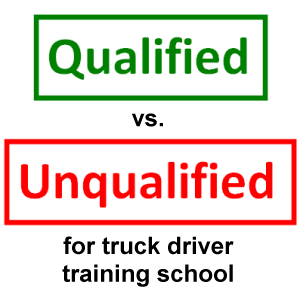 There is no sense in learning how to drive a heavy truck if no trucking company will hire you once you “graduate.”
There is no sense in learning how to drive a heavy truck if no trucking company will hire you once you “graduate.”
The Federal Motor Carrier Safety Administration (FMCSA) lists Part 391: Qualifications of drivers and longer combination vehicle (LCV) driver instructors.
Review this and linked lists to make sure that you’re eligible to be hired by a motor carrier by meeting all of the qualifications.
If you’re not, it’s better to know early on.
Trucking company applications will ask questions like these:
- Have ever been convicted of a felony or any drug-related charges?
- Have you had a DUI (driving under the influence of alcohol and/or drugs) / DWI (driving while intoxicated) / PI (public intoxication) conviction in the past 10 years?
- Have you had a reckless driving violation in the past 10 years?
- Were you at fault in any driving accidents in the last year?
- Have you ever failed or refused a drug test?
- Have you had more than 3 moving violations in the past 3 years?
- Have you had more than 2 preventable accidents in the past 3 years?
- Has your license been suspended for any reason in the past 3 years?
- Have you had any traffic convictions for excessive speeding, as defined by DOT, more than 15 mph over the limit, or following too close in the past 3 years?
If there’s any doubt in your mind about what’s on your record:
- buy a copy of your Motor Vehicle Record (MVR) from your state’s Department of Motor Vehicles and review it for moving violations, and/or
- buy a copy of your criminal history record from your state’s Law Enforcement Division and review it for potential hindrances to future employment.
Once you know you’re hirable, proceed with selecting a suitable school.
At one time, the U.S. Department of Education had prepared a section on its website entitled “Career Colleges and Technical Schools – Questions to Ask Before Enrolling.”
Truck Driver Training Schools: Physical Fitness
Additionally, the FMCSA lists “Entry-level driver training requirements.” Before you can even take a road test, you will be required to pass a DOT physical.
Read more about the DOT Medical Exam and CMV Certification and see the “Medical Examination Report for Commercial Driver Fitness Determination.”
Truck Driver Training Schools: Types of Schools
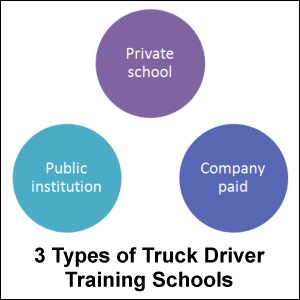 The three basic types of truck driver training schools are:
The three basic types of truck driver training schools are:
- private schools (for-profit businesses);
- motor carriers (also called “company-paid” truck driver training); and
- public institutions (funded at least partially by the government, these include trade, vocational or technical schools; community colleges; and some state colleges).
For every “pro” (favorable aspect) of a particular type of truck driving school, there is a reverse “con” (unfavorable aspect).
For example, a school that has a longer length of course may be more thorough in what it taught, but it will most likely be more expensive than a school with a shorter length of course.
Very soon, we will provide a list of pros and cons for private for-profit trucking schools and motor carrier CDL training, aka “paid CDL training” or “company paid CDL training.”
When we were looking at truck driver training schools in 1992, we contacted a number of private schools in our general area and were not impressed by their set-ups.
Frankly, their rinky-dink set-ups never gained traction and they went out of business pretty quickly.
Of course, you will need to evaluate all of your options and we’ll tell you how farther down on this page.
We attended truck driver training school at a public institution in Charleston, SC.
Because of the quality of the training program, they were able to provide us with access to financial aid, which we accepted through the form of federal student loans.
We have worked for trucking companies that had both entry level truck driver training (Swift and Schneider) as well as refresher truck driver training (Schneider and Epes Transport) for experienced drivers with non-recent OTR experience.
In Aiken County, SC, a technical college has partnered with a truck driver training school within the state to provide quality CDL truck driver training.
Truck Driver Training Schools: Evaluation Process
Have you ever seen a website listing CDL training schools without telling you how they evaluated them?
Or a website that claims that they only list “the best” truck driver schools without telling you how they determined that?
 Since this is your education and your career, for your own sake, evaluate the schools yourself.
Since this is your education and your career, for your own sake, evaluate the schools yourself.
When we went to truck driver training school, we didn’t know what to look for and took a lot of things on faith.
If we had to do it over again, you can rest assured, we’d go into it with our eyes wide open.
Recruiters for truck driver training schools, similar to recruiters for truck driving companies, are looking for students to fill seats.
Filled seats mean more revenue for them.
Don’t fall for their well-rehearsed lines.
Ask about the school’s
- licensing (done by the state, as evidence of meeting minimum standards),
- accreditation (done by a U.S. Department of Education-approved accrediting agency, as evidence of other strict standards), and
- certification (done through PTDI, as evidence of meeting the training standard of the trucking industry).
Get the truck driver training school’s catalog and do some preliminary fact-finding regarding
- the length of the course (in days or weeks);
- the number hours truck driver training school students are supposed to spend
- in the classroom and
- on the driving range;
- all costs (which we’ll cover below);
- the qualifications of the truck driver training school instructors (who most likely will be former truckers themselves); and
- the school’s job placement rate (percentage of course graduates with offers of employment).
Truck Driver Training Schools: The Initial Inspection
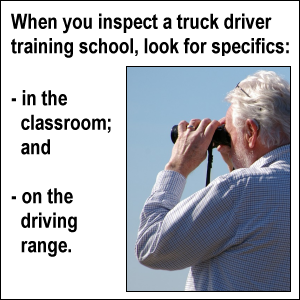 Arrange to visit the school when a class of truck driver training students is in session (preferably so you can visit both the classroom and driving range areas).
Arrange to visit the school when a class of truck driver training students is in session (preferably so you can visit both the classroom and driving range areas).
When you inspect the classroom, look at or for
- the number of desks in the classroom (to determine the student-instructor ratio; smaller is better);
- the atmosphere of the classroom (well lit, well ventilated, comfortable temperature);
- how well the students seem to understand the instructor;
- all of the books and materials being used by both students and instructor;
- the audio-visual materials and library;
- the other visual aids and tools for use in the class.
When we were in truck driver training school in 1992, we saw some videos to supplement the training from our classroom instructor. Technology has come a long way since then.
When you inspect the driving range, look at or for
- the number of students assigned to each instructor (to determine the student-instructor ratio; smaller is better);
- the number of students assigned to each truck (to determine the student-truck ratio; smaller is better);
- the safety, condition and age of the trucks being used (preferably late model equipment, like what is on the road today);
- the location of the driving range (preferably in a place where there is no public through traffic, but close enough to interstate and in-city driving areas for students to practice);
- the condition and use of equipment being used on the driving range (cones, barrels, painted lines, backboard, etc.); and
- the condition of the range (well lit, adequate space to maneuver trucks, areas where students may learn and practice different skills such as truck inspections, coupling, stop line, backing, 90° alley docking, serpentine, sliding tandems, etc.).
Truck Driver Training Schools: Know the Costs
 Besides the tuition for attending truck driver training school (and any associated “allowance” that student drivers may receive), you may incur other costs, including but not limited to:
Besides the tuition for attending truck driver training school (and any associated “allowance” that student drivers may receive), you may incur other costs, including but not limited to:
- DOT physical (for your medical card),
- DOT drug screen (to test for controlled substances),
- textbooks,
- road atlas,
- Class A permit fee,
- Class A license fee, and
- endorsement test fee(s).
Make sure you know all of these costs in advance.
Ask for a list.
Also, although you may not be planning for it when you plan to attend truck driver training school, emergencies can arise.
If you have to leave the school for any reason (such as for medical reasons or a family crisis), find out if you can:
- get a refund,
- re-start taking classes later, or
- can transfer your training time to another school.
This may be especially important for those who embark on company-paid CDL training.
If you need financial aid, you may want to read our page on federal student loans.
Truck Driver Training Schools: The Curriculum
Book knowledge by itself will not adequately prepare you for your road test or your career as a professional driver.
But there are certain fundamentals that you need to know before you can drive a big rig.
Your truck driver training school will most likely use a book like the one we used: Bumper to Bumper: The Complete Guide to Tractor-Trailer Operations
You can get a head start on learning by getting and reading the book before you go to school.
For your convenience, we have provided the link from Amazon.com, with which we have an affiliate relationship.
You will also want to familiarize yourself with a Motor Carriers’ version of a road atlas, which includes invaluable information for professional drivers of commercial vehicles, such as:
- truck routes,
- low clearances and
- the contact information for state Departments of Motor Vehicles.
Your truck driver training school will most likely provide you with a paperback atlas.
It doesn’t take too much steady use by new drivers for a paperback atlas to completely go to shreds. (Both of ours did.)
For that reason, we greatly prefer — and Mike uses — a spiral-bound atlas with laminated pages, like the
[adinserter block=”1″]
Older editions are kept at home or stowed in the car. (Imagine the great lessons on geography that a professional driver can give his family back home with an old atlas.)
Truck Driver Training Schools: The Tests
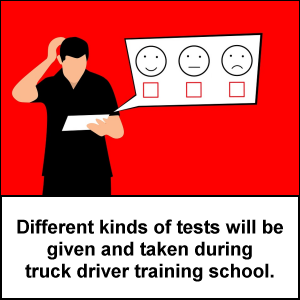 If your truck driver training school is worth its salt, you will have a considerable number of commercial driver’s license written exam practice tests.
If your truck driver training school is worth its salt, you will have a considerable number of commercial driver’s license written exam practice tests.
When we were in school, we received a 46-page stapled handout entitled “Student Workbook and Study Guide for the Commercial Driver’s License Written Exam.”
This exam or test was packed full of questions for us to master in preparation for taking our own tests.
And speaking of tests…
When we were in school in 1992, our classroom instructor was an old tanker driver named Roger. He was serious as could be, but knew how to “pick on” his students, partly in fun, to see how they could handle the pressure of life on the road. Some students didn’t do too well under this perceived persecution.
We recall one incident where he was grading a particular practice test. Roger graded Vicki’s test first. When she made a perfect score, he wrote a big
100
at the top and circled it.
Next, he graded Mike’s test.
When he made a perfect score, Roger wrote a tiny
100
at the top and circled it. He slid Mike’s test across the desk to Mike and looked up. He said, “See? She still makes a bigger ‘100’ than you do!”
We both just laughed. We could handle the humor.
Believe it or not, being able to laugh is a test. Some drivers take themselves way too seriously. They get offended at the least little thing.
On the last day of class, after everyone else had left, we asked Roger what he thought our chances of success were in trucking. He spoke very positively, saying that he knew from the very first day of truck driver training school that we would make it. When we asked him how he knew, he just said that he had been teaching long enough to know that there were some students who were going to make it and some who weren’t.
In addition to classroom instruction, prospective commercial drivers should receive a certain amount of driving range instruction.
Truck Driver Training Schools: Driving Range Time
Your time on the driving range will include some driving time and non-driving time.
An example of non-driving time will be learning how to do your pre-trip inspection (which you can obtain through our Free Downloads page).
You need to be aware that there are differences in the definitions used by some truck driver training schools for driving range time:
- observation time,
- behind the wheel time, and
- driving time
Ask the school how much actual driving time you will be given during your training program.
You will not be paying money just to stand by or sit in the cab of a truck watching other students drive.
If you’re not getting enough actual driving time or practice on a specific maneuver, speak up.
For additional information on skills needed to get your CDL, see our CDL road test page.
Truck Driver Training Schools: Getting Your CDL Endorsements
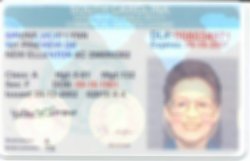 Professional drivers who have certain endorsements on their commercial driver licenses are able to haul cargo or equipment that drivers without those endorsements cannot haul.
Professional drivers who have certain endorsements on their commercial driver licenses are able to haul cargo or equipment that drivers without those endorsements cannot haul.
Mike knows from personal experience that having a HazMat endorsement on his CDL has come in handy when being routed to an area where the only outgoing loads consist of hazardous materials.
He can pick up the paint load and go whereas a driver without the HazMat endorsement has to sit and wait on a non-HazMat load.
So, as long as you’re going through truck driver training school and you’re going to be tested, you might as well get these endorsements:
- HazMat,
- Tankers, and
- Doubles and triples.
Consider making it your goal to have no restrictions — other than corrective lenses, if you wear them — on your commercial driver’s license.
Look upon your time in truck driver training school as part of your professional trucking career.
Truck Driver Training Schools: Job Placement and Employment
 When we went to truck driver training school, the school we chose promised us three things by the end of our course of study:
When we went to truck driver training school, the school we chose promised us three things by the end of our course of study:
- a certificate of completion,
- a commercial driver’s license (CDL), and
- at least one job offer from a trucking company.
During the latter part of our time at the school, recruiters from various trucking companies came in and made their “pitch” to us.
In addition to listening to their spiels, we studied the material that the truck driver training school had on hand.
Since both of us had gone through exactly the same course of study at the same time, we felt that we were equally qualified to be hired by any trucking company hiring teams.
As it turned out, one of the trucking companies that offered Vicki employment did not offer employment to Mike.
Since we were interested only in working together as a team, that company was not among those that we considered.
The way that the trucking company we were considering being hired by worked the pay scale, the “first seat driver” got a one-cent-per-mile higher rate of pay than the “second seat driver.”
We got kidded by a few of the student drivers in our class.
They would speak to us separately, asking, “Are you going to let him/her earn a penny more per mile than you are?”
Of course, we weren’t concerned about that because every penny we planned to earn would go into our joint checking account.
Some truck driver training schools offer one-time job placement services (upon a student driver’s graduation from school) while others offer lifetime job placement.
Only you will be able to determine if this is an issue for you.
What About Skipping Paid Training and Getting a Free CDL?
There are numerous trucking companies that advertise no-money-down company-paid training so you can get a “free CDL.”
Just because the training won’t cost you money up-front, you can rest assured that there is a cost involved. Read our page for more information.
Additional Resources About Truck Driver Training Schools
- CDL Information for Students, New Drivers, and those Looking into Trucking
- Considering changing careers
- Considering changing careers 2
- Fail Trucking Company School
- john’s public intoxication charge
- Low pay in trucking
- Question about Truck driving school!…
- Trying to find loans
- WIA Grant
- Fail Trucking Company School
![]() Money saving tip: Review the material on this page for the following tips before you go to truck driver training school:
Money saving tip: Review the material on this page for the following tips before you go to truck driver training school:
- Meeting all of the FMCSA qualifications to drive a truck;
- Meeting all of the physical fitness requirements;
- Knowing the pros and cons of each type of truck driving school;
- Inspecting the school for certain criteria;
- Knowing all of the costs involved in the training program;
- Knowing which curriculum you will study;
- Understanding which tests you will take in the classroom and on the driving range;
- Knowing the differences in definitions used for driving range time;
- Not limiting your CDL endorsement options; and
- Understanding the job placement services that the school offers.
Resources
Trucking Careers of America LLC: We put America’s OTR truck drivers to work and help you plan for a successful truck driving career.
truckingcareersofamerica.com/ (no longer online)






